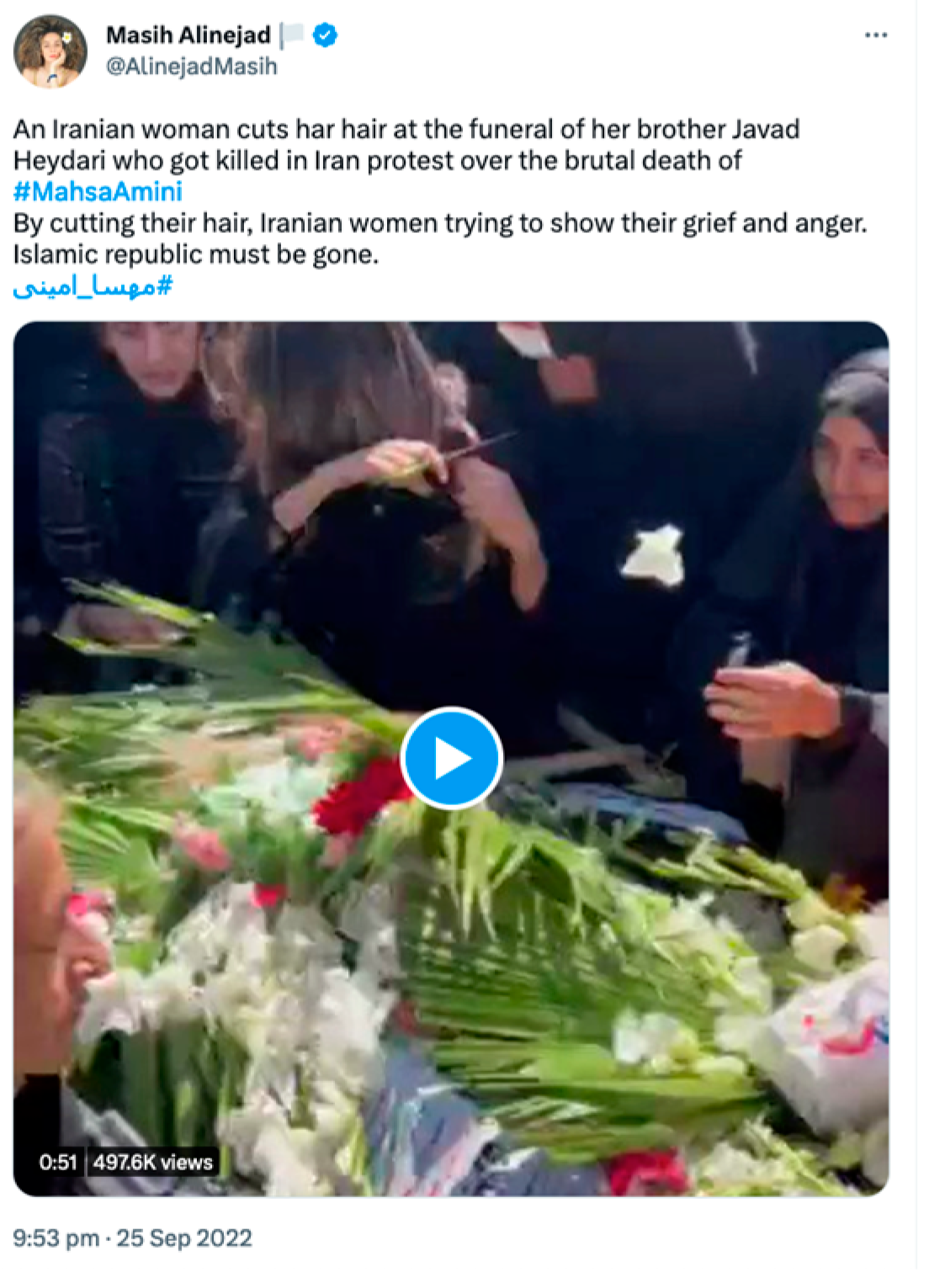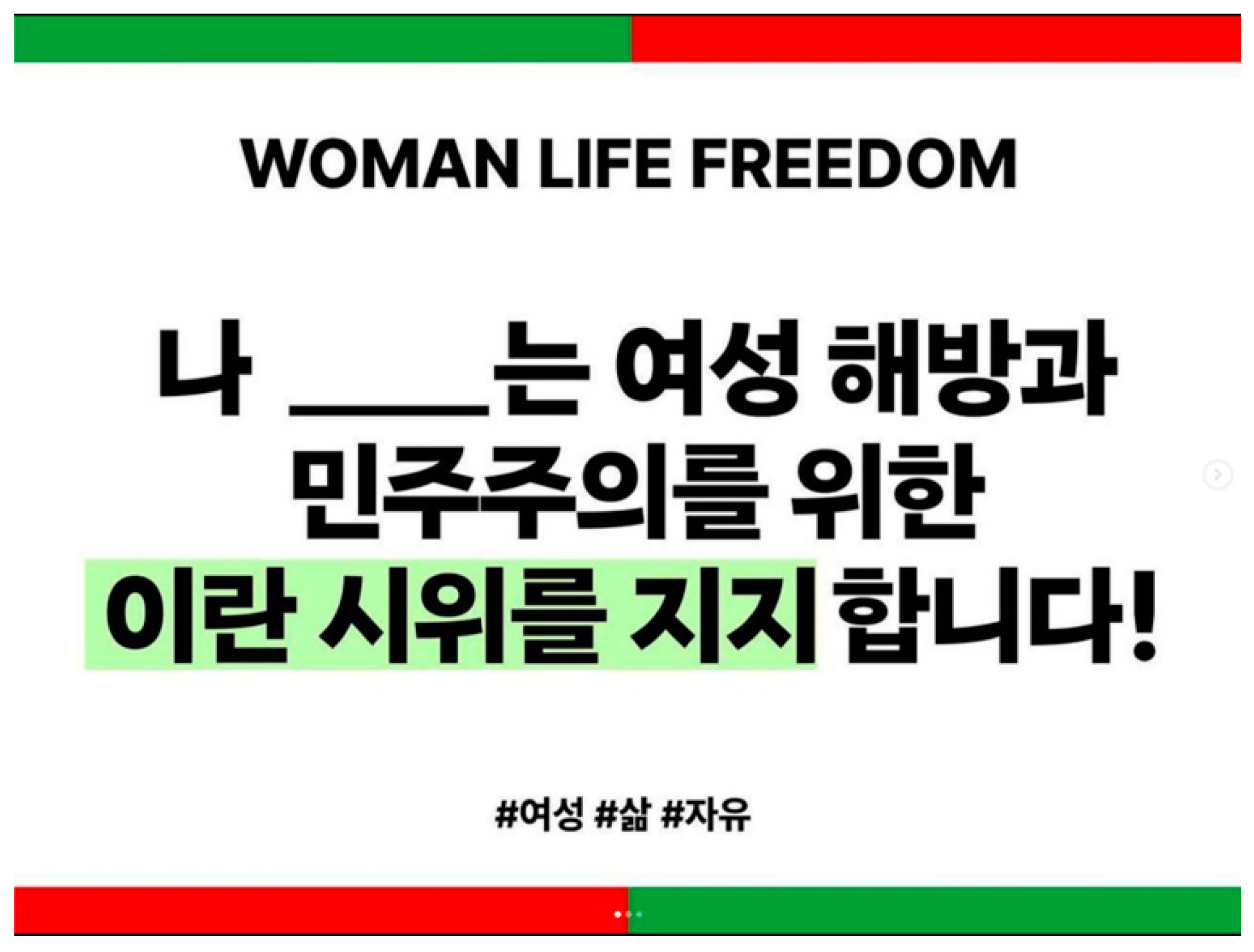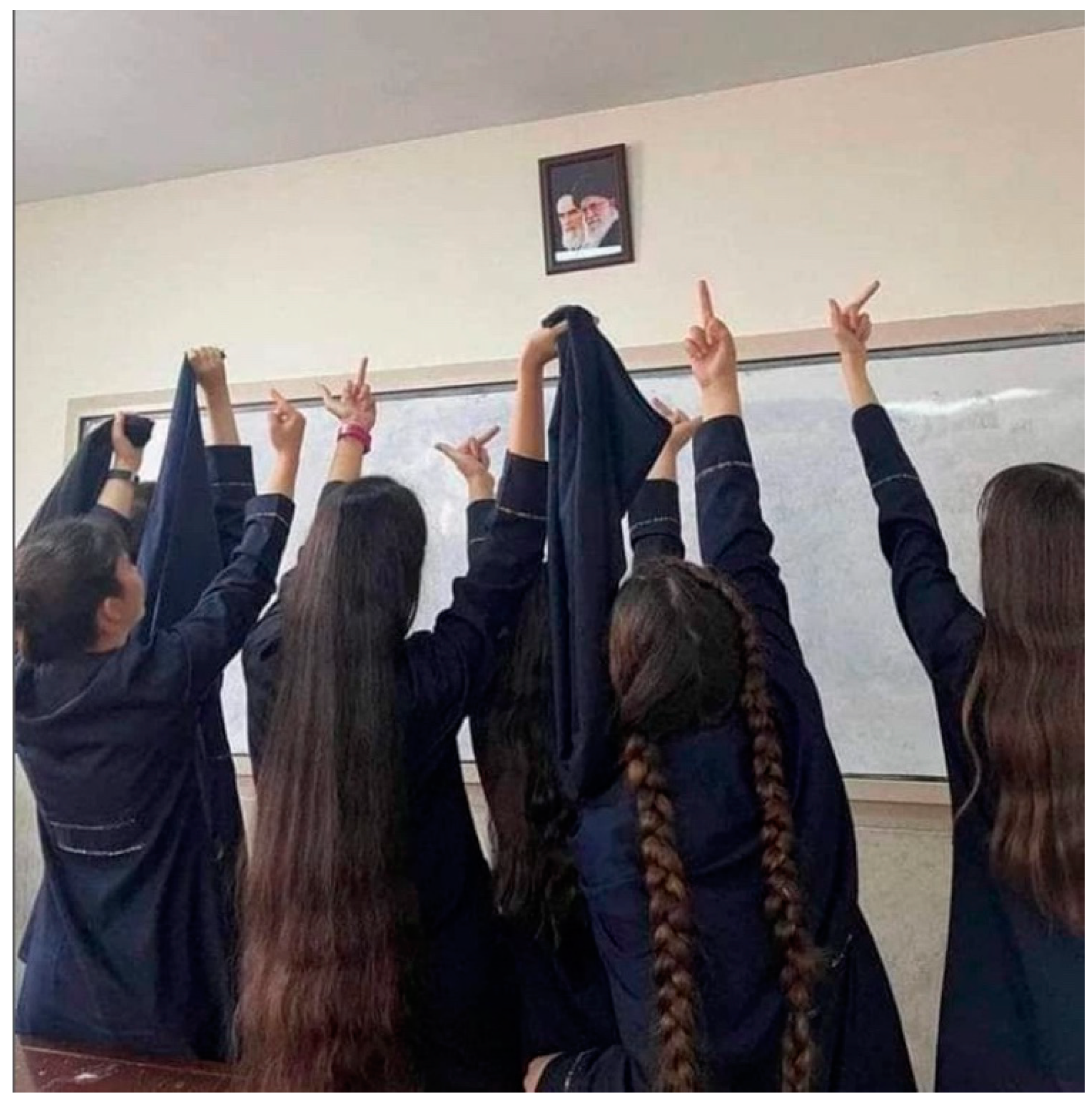“Hair for Freedom” Movement in Iran: Interreligious Dialogue in Social Media Activism?
Abstract
1. Introduction
- RQ 1.
- What were the most prevalent themes that emerged from “Hair for Freedom’s” social media posts? Did “Hair for Freedom’s” posts focus principally on Islam, women’s rights, or some other topic?
- RQ 2.
- To what degree did religious values or beliefs prompt people to generate social media posts about “Hair for Freedom”?
- RQ 3.
- Did the social media exchange over “Hair for Freedom” prompt intrareligious, interreligious, or suprareligious dialogue?
2. Theoretical Framework
2.1. Interreligious Dialogue (IRD) on Social Media
2.2. Digital Feminism and Religion
3. Methods
3.1. Sample
3.2. Data Analysis
4. Findings
5. Discussion and Conclusions
Author Contributions
Funding
Informed Consent Statement
Data Availability Statement
Conflicts of Interest
References
- Arcila-Calderón, Carlos, David Blanco-Herrero, Maximiliano Frías-Vázquez, and Francisco Seoane-Pérez. 2021. Refugees welcome? Online hate speech and sentiments in Twitter in Spain during the reception of the boat Aquarius. Sustainability 13: 2728. [Google Scholar] [CrossRef]
- Banet-Weiser, Sarah, and Laura Portwood-Stacer. 2017. The traffic in feminism: An introduction to the commentary and criticism on popular feminism. Feminist Media Studies 17: 884–88. [Google Scholar] [CrossRef]
- Baumgardner, Jennifer. 2011. F ’em!: Goo Goo, Gaga, and Some Thoughts on Balls. Berkeley: Seal Press. [Google Scholar]
- BBC. 2022a. Iran Protests: Raisi to ‘Deal Decisively’ with Widespread Unrest. September 24. Available online: https://www.bbc.co.uk/news/world-middle-east-63021113 (accessed on 28 February 2023).
- BBC. 2022b. Iran Unrest: What’s Going on with Iran and the Internet? September 24. Available online: https://www.bbc.com/news/technology-62996100 (accessed on 1 March 2023).
- Bernhardt, Reinhold. 2020. Concepts and Practice of Interreligious and Socio-Religious Dialogue. In Religious Diversity and Interreligious Dialogue. Edited by Anna Körs, Wolfram Weisse and Jean-Paul Willaime. Cham: Springer International Publishing, pp. 239–49. [Google Scholar]
- Bilge, Sirma. 2010. Beyond subordination vs. resistance: An intersectional approach to the agency of veiled Muslim women. Journal of Intercultural Studies 31: 9–28. [Google Scholar] [CrossRef]
- Bracke, Sarah, and Nadil Fadil. 2012. Is the headscarf oppressive or emancipatory? Field notes from the multicultural debate. Religion and Gender 2: 36–56. [Google Scholar] [CrossRef]
- Castells, Manuel. 2009. Communication Power. Oxford: Oxford University Press. [Google Scholar]
- Corpuz, Jeff Clyde G. 2021. Religions in action: The role of interreligious dialogue in the COVID-19 pandemic. Journal of Public Health 43: e236–e237. [Google Scholar] [CrossRef] [PubMed]
- Council of Europe. 2008. White Paper on Intercultural Dialogue: ‘Living Together as Equals in Dignity’. Available online: www.coe.int/dialogue (accessed on 7 January 2023).
- de Perini, Pietro, and Desirée Campagna. 2022. The fuzzy place of interreligious dialogue in the international community’s intercultural dialogue efforts. International Journal of Cultural Policy 28: 400–18. [Google Scholar] [CrossRef]
- Eagle, Ryan Bowles. 2015. Loitering, lingering, hashtagging: Women reclaiming public space via #BoardtheBus, #StopStreetHarassment, and the #EverydaySexism Project. Feminist Media Studies 15: 350–53. [Google Scholar] [CrossRef]
- Giordan, Giuseppe, and Andrew P. Lynch. 2019. Interreligious dialogue: From religion to geopolitics. Annual Review of the Sociology of Religion 10: 1–9. [Google Scholar]
- Giorgi, Alberta. 2021. Religious feminists and the intersectional feminist movements: Insights from a case study. European Journal of Women’s Studies 28: 244–59. [Google Scholar] [CrossRef]
- Giraldo-Luque, Santiago, Núria Fernández-García, and José-Cristian Pérez-Arce. 2018. La centralidad temática de la movilización #NiUnaMenos en Twitter. El Profesional de la Información 27: 96–105. [Google Scholar] [CrossRef]
- González, Alexander. 2020. In Search of a Common Base for Interreligious Dialogue: Beyond “a Common Word” between Muslims and Christians. Bogotá: Universidad Libre. [Google Scholar] [CrossRef]
- Hirji, Faiza. 2021. Claiming our space: Muslim women, activism, and social media. Islamophobia Studies Journal 6: 78–92. [Google Scholar] [CrossRef]
- Khamidov, Evgeny. 2021. At the Grassroots of Interreligious Dialogue Activities. In Talking Dialogue. Edited by Karsten Lehman. Berlin: De Gruyter, pp. 151–78. [Google Scholar] [CrossRef]
- Khan, Issa, Mohammad Elius, Mohd Roslan Mohd Nor, Mohd Yakub Zulkifli Bin Mohd Yusoff, Kamaruzaman Noordin, and Fadillah Mansor. 2020. A critical appraisal of interreligious dialogue in Islam. SAGE Open 10: 215824402097056. [Google Scholar] [CrossRef]
- Kim, Jinsook. 2017. #iamafeminist as the “Mother Tag”: Feminist identification and activism against misogyny on Twitter in South Korea. Feminist Media Studies 17: 804. [Google Scholar] [CrossRef]
- Klinkhammer, Gritt. 2020. Interreligious dialogue groups and the mass media. Religion 50: 336–52. [Google Scholar] [CrossRef]
- Körs, Anna, Wolfram Weisse, and Jean-Paul Willaime, eds. 2020. Introduction: Religious Diversity and Interreligious Dialogue. In Religious Diversity and Interreligious Dialogue. Cham: Springer International Publishing, pp. 1–17. [Google Scholar] [CrossRef]
- Lafrarchi, Naïma. 2021. Intra- and interreligious dialogue in Flemish (Belgian) secondary education as a tool to prevent radicalisation. Religion 12: 434. [Google Scholar] [CrossRef]
- Lelono, Martinus Joko. 2021. Internet-mediated interreligious dialogue a study case on @KatolikG’s model of dialogue. Journal of Asian Orientation in Theology 3: 149–74. [Google Scholar] [CrossRef]
- Leung, Rebecca, and Robert Williams. 2019. #MeToo and intersectionality: An examination of the #MeToo movement through the R. Kelly scandal. Journal of Communication Inquiry 43: 349–71. [Google Scholar]
- Llorent-Bedmar, Vicente, Lucía Torres-Zaragoza, and Encarnación Sánchez-Lissen. 2023. The use of religious signs in schools in Germany, France, England and Spain: The Islamic Veil. Religions 14: 101. [Google Scholar] [CrossRef]
- Maloney, Abbey Rose. 2017. Influence of the Kardashian–Jenners on fourth wave feminism. Elon Journal of Undergraduate Research in Communications 8: 48–59. [Google Scholar]
- Melnik, Sergey Vladislavovich. 2020. Classification of types of interreligious dialogue. Communicology 8: 25–51. [Google Scholar] [CrossRef]
- Mincheva, Dilyana. 2021. #DearSister and #MosqueMeToo: Adversarial Islamic feminism within the Western–Islamic public sphere. Feminist Media Studies, 1–16. [Google Scholar] [CrossRef]
- Munroe, Ealasaid. 2013. Feminism: A fourth wave? Political Insight 4: 22–25. [Google Scholar] [CrossRef]
- Noh, Minjung. 2021. Implementing Interreligious Dialogue. In Talking Dialogue. Edited by Karsten Lehman. Berlin: De Gruyter, pp. 327–52. [Google Scholar] [CrossRef]
- Novak, Cristoph, Miriam Haselbacher, Astrid Mattes, and Katharina Limacher. 2022. Religious “bubbles” in a superdiverse digital landscape? Research with religious youth on Instagram. Religions 13: 213. [Google Scholar] [CrossRef]
- Nyhagen, Line. 2017. The lived religion approach in the sociology of religion and its implications for secular feminist analyses of religion. Social Compass 64: 495–511. [Google Scholar] [CrossRef]
- Petrov, George Daniel, and Victor Marius Pleșa. 2021. Interreligious dialogue and socio-religious dialogue in today’s society. Technium Social Sciences Journal 25: 754–58. [Google Scholar] [CrossRef]
- Polak, Regina. 2020. Between theological ideals and empirical realities: Complex diversity in interreligious dialogue. Interdisciplinary Journal for Religion and Transformation in Contemporary Society 6: 274–92. [Google Scholar] [CrossRef]
- Price, Monroe. 2015. Free Expression, Globalism, and the New Strategic Communication. Cambridge: Cambridge University Press. [Google Scholar]
- Rosenberger, Sieglinde, and Birgit Sauer, eds. 2012. Politics, Religion and Gender: Framing and Regulating the Veil. Oxford: Routledge. [Google Scholar]
- Schmidt-Leukel, Perry. 2020. The Relevance of Interreligious Dialogue in the Public Sphere. Some Misgivings. In Religious Diversity and Interreligious Dialogue. Edited by Anna Körs, Wolfram Weisse and Jean-Paul Willaime. Cham: Springer International Publishing, pp. 259–64. [Google Scholar] [CrossRef]
- Stevens, Keith, Philip Kegelmeyer, David Andrzejewski, and David Buttler. 2012. Exploring topic coherence over many models and many topics. Paper presented at the 2012 Joint Conference on Empirical Methods in Natural Language Processing and Computational Natural Language Learning, Jeju, Korea, July 12–14; Stroudsburg: ACL, pp. 952–61. [Google Scholar]
- Tabrizy, Nilo, Nailah Morgan, and Axel Boada. 2022. Protests Surge in Iran as Crackdown Escalates. New York Times. September 24. Available online: https://www.nytimes.com/video/world/middleeast/100000008550828/mahsa-amini-iran-protests.html?playlistId=video/news-clips (accessed on 28 February 2023).
- Tsuria, Ruth. 2020. The space between us: Considering online media for interreligious dialogue. Religion 50: 437–54. [Google Scholar] [CrossRef]
- Van den Brandt, Nella, and Chia Longman. 2017. Working against many grains: Rethinking difference, emancipation and agency in the counter-discourse of an ethnic minority women’s organisation in Belgium. Social Compass 64: 512–29. [Google Scholar] [CrossRef] [PubMed]
- West, Christopher. 2021. The future of interreligious dialogue. The Ecumenical Review 73: 714–22. [Google Scholar] [CrossRef]
- Zarkov, Dubravka, and Kathy Davis. 2018. Ambiguities and dilemmas around #MeToo: #ForHow Long and #WhereTo? European Journal of Women’s Studies 25: 3–9. [Google Scholar] [CrossRef]
- Zimmerman, Tegan. 2017. #Intersectionality: The fourth wave feminist Twitter community. Atlantis 38: 54–70. [Google Scholar]



| Number of Posts | |
|---|---|
| 3915 (565 original tweets) | |
| 431 | |
| TikTok | 92 |
| Topic | Main Words | Dominant Topic | Example Post |
|---|---|---|---|
| Women’s rights and the veil | women, body, cut, death, veil, free, justice, participate, feminism, hijab | 49.7% | The Iranian government is forcing women to wear hijabs and even kills if they don’t follow a fixed way of wearing it. Masha Amini’s death is not a one-off event. Freedom for Women!!! #HairforFreedom |
| Actresses and influencers | solidarity, support, actresses, French, Korean, picture, video, cut, Iran, please | 38.9% | French Oscar winners cut off their hair to support Iranian women protesting Hijab policy. When will Bollywood join the Bandwagon? #HairForFreedom |
| People rights in general | fight, peace, world, courage, Persian, force, rights, brave, people, police | 11.4% | For the courageous women and men of Iran who are changing the world at this very moment, fighting for freedom and human rights. We stand by you. #HairForFreedom #Iran |
| TikTok | Total | |||
|---|---|---|---|---|
| English | 43.36% | 32.25% | 47.56% | 39.24% |
| Spanish | 21.42% | 9.74% | 10.98% | 15.96% |
| French | 11.50% | 18.10% | 9.76% | 14.01% |
| Italian | 3.54% | 16.94% | 10.98% | 9.46% |
| Korean | 5.66% | 7.19% | 5.84% | |
| Persian | 2.12% | 4.18% | 9.76% | 3.53% |
| Portuguese | 2.48% | 3.25% | 2.44% | 2.78% |
| Russian | 2.12% | 0.93% | 1.48% | |
| Catalan | 1.95% | 0.46% | 1.22% | 1.30% |
| Hindi | 0.53% | 1.39% | 2.44% | 1.02% |
| German | 0.88% | 0.93% | 1.22% | 0.93% |
| Dutch | 1.24% | 0.23% | 0.74% | |
| Greek | 0.71% | 0.23% | 0.46% | |
| Turkish | 0.53% | 0.23% | 0.37% | |
| Arabic | 0.70% | 0.28% | ||
| Romanian | 0.70% | 0.28% | ||
| Thai | 0.18% | 0.23% | 1.22% | 0.28% |
| Finnish | 0.18% | 0.23% | 0.19% | |
| Croatian | 0.23% | 1.22% | 0.19% | |
| Japanese | 0.35% | 0.19% | ||
| Slovak | 0.23% | 1.22% | 0.19% | |
| Telugu | 0.35% | 0.19% | ||
| Bulgarian | 0.23% | 0.09% | ||
| Gujarati | 0.23% | 0.09% | ||
| Haitian | 0.18% | 0.09% | ||
| Indonesian | 0.23% | 0.09% | ||
| Polish | 0.23% | 0.09% | ||
| Albanian | 0.18% | 0.09% | ||
| Swahili | 0.23% | 0.09% | ||
| Tamil | 0.23% | 0.09% | ||
| Urdu | 0.18% | 0.09% | ||
| Chinese | 0.23% | 0.09% | ||
| Undefined | 0.35% | 0.19% |
| TikTok | ||||||
|---|---|---|---|---|---|---|
| Topic | Likes | Comments | Likes | Comments | Likes | Comments |
| Women’s rights and the veil | 8.6 | 1.06 | 313.8 | 12.25 | 2123 | 28.45 |
| Actresses and influencers | 6.63 | 1.12 | 254.83 | 12.72 | 2236.8 | 12.2 |
| People’s rights in general | 6 | 1.5 | 82.13 | 4.31 | 75 | 2.1 |
Disclaimer/Publisher’s Note: The statements, opinions and data contained in all publications are solely those of the individual author(s) and contributor(s) and not of MDPI and/or the editor(s). MDPI and/or the editor(s) disclaim responsibility for any injury to people or property resulting from any ideas, methods, instructions or products referred to in the content. |
© 2023 by the authors. Licensee MDPI, Basel, Switzerland. This article is an open access article distributed under the terms and conditions of the Creative Commons Attribution (CC BY) license (https://creativecommons.org/licenses/by/4.0/).
Share and Cite
Navarro, C.; Peres-Neto, L. “Hair for Freedom” Movement in Iran: Interreligious Dialogue in Social Media Activism? Religions 2023, 14, 602. https://doi.org/10.3390/rel14050602
Navarro C, Peres-Neto L. “Hair for Freedom” Movement in Iran: Interreligious Dialogue in Social Media Activism? Religions. 2023; 14(5):602. https://doi.org/10.3390/rel14050602
Chicago/Turabian StyleNavarro, Celina, and Luiz Peres-Neto. 2023. "“Hair for Freedom” Movement in Iran: Interreligious Dialogue in Social Media Activism?" Religions 14, no. 5: 602. https://doi.org/10.3390/rel14050602
APA StyleNavarro, C., & Peres-Neto, L. (2023). “Hair for Freedom” Movement in Iran: Interreligious Dialogue in Social Media Activism? Religions, 14(5), 602. https://doi.org/10.3390/rel14050602







